West Africa's Unsung Hero
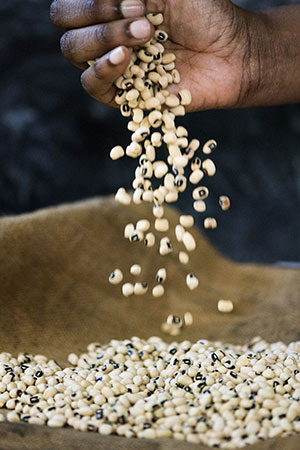
We all have those childhood meals that remain comforting and familiar well into our adult lives. For me, that meal is not a meal at all, but an ingredient – black-eyed beans. Growing up in a Nigerian household, these beans were not only a staple but a testament to my family’s heritage, and though I didn’t fully appreciate their value back then, I’ve long since come to realize the incredible versatility and significance of black-eyed beans in Nigerian and West African cooking.
Black-eyed beans are like the unsung heroes of West African food. While many turn to potatoes, rice, or bread as their primary source of starch, these legumes offer a filling and delicious alternative. Yet for all of their attributes and affordability, they are often overlooked outside of West Africa. So much so that they’re a fundamental component of countless Nigerian dishes, providing sustenance and flavor on a budget. But it is not just the cost that makes black-eyed beans so praised in West Africa – it’s the process of preparing them, an act of love that remains deeply ingrained in the culture.
Even growing up in the UK, black-eyed beans have always played a big part in my identity, going beyond food and into my Nigerian heritage.
Western Vs Nigerian Black-Eyed Beans
For people that are new to Nigerian or West African food, you might think that the standard black-eyed beans you can buy from a supermarket are as good as you can get, but any Nigerian will know that the quality of Western black-eyed beans doesn’t even come close to the beans you’d find in Nigeria. The difference between the two types of black-eyed beans is so striking that my parents still to this day load up on black-eyed beans whenever they visit family in Nigeria just to be able to experience black-eyed beans at their best.
Nigerian black-eyed beans are smoother and allow you to really taste the flavor of the beans themselves, as Western black-eyed beans bought in supermarkets do not have much flavor once cooked and lack that smoothness that makes the beans so versatile in the first place. That is why, at my restaurant, we opt for African and Caribbean-sourced produce when working with this ingredient.
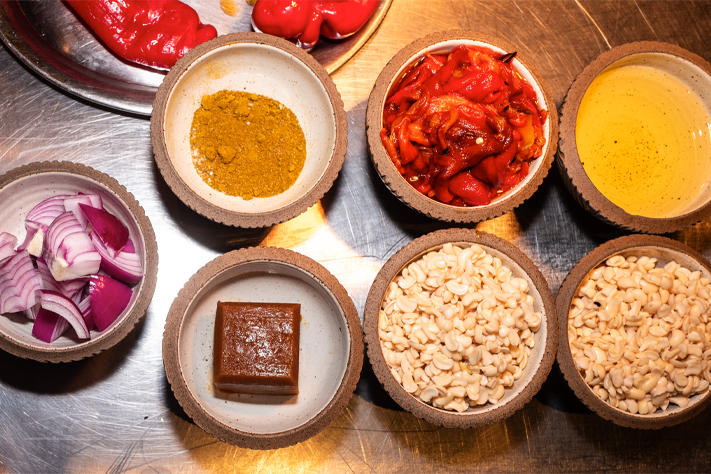
Moin-Moin
Seeing as black-eyed beans are such a staple in Nigerian cuisine, a lot of the meals I ate during childhood made full use of the beans whenever possible. One of the most iconic dishes, and one of my personal favorites that also shows off the range of black-eyed beans is moin-moin – a steamed black-eyed bean pudding.
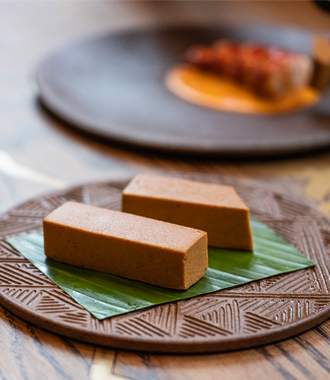
The magic of moin-moin is the smooth, velvety texture that is produced by removing the outer skin from the black-eyed beans, a process that can be laborious when done by hand yet is absolutely vital if you want that perfect texture. Nigerian cooks have a clever trick that I picked up from my mum and aunties that involves soaking the beans overnight. When left for long enough, the skin of the beans floats while the beans themselves sink, making the dish a whole lot less time-consuming.
Moin-moin’s charm lies in its ability to incorporate a wide range of flavors into the batter before steaming. I’ve had countless servings of moin-moin in my life, each with its own flavor and addition. Most often, I’d enjoy a plate or two of flavor-packed moin-moin at parties and weddings where it tends to be served with hearty stews or a range of veggies and meats, creating a taste that goes beyond nostalgia and into life-long memories.
If you are trying Nigerian food for the first time and want to keep things simple, akara is another black-eyed bean creation that’s often overlooked by people new to Nigerian cuisine. Like moin-moin, it starts with soaking and blending the beans. However, akara keeps it simple in terms of seasonings. While it may not boast the same complexity of flavors as moin-moin, the whipped then fried soufflé texture is beautiful.
In my restaurant, I stick mostly with moin-moin, not just because of how much flavor can be packed into the pudding itself but also what it can be paired with. We change up what we pair with moin-moin but tend to stick with seafood such as a fresh piece of Cornish mackerel or lobster, always keeping the moin-moin the star of the dish.
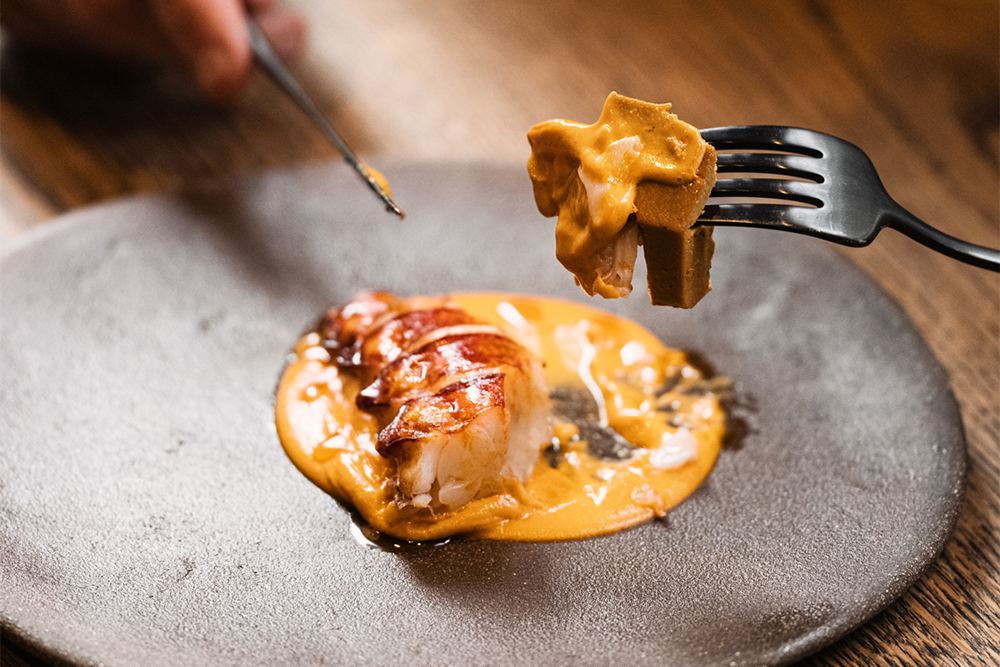
Acarajé
The versatility of black-eyed beans isn’t exclusive to Africa; they’ve traveled the world, giving birth to fusion dishes like acarajé. Nigeria’s take on acarajé is a burger-like dish that comes as a result of treating the black-eyed beans like any other protein. The beans are still lovingly washed and soaked overnight before being de-skinned, but once they are then blended together, they can be shaped and treated like a smooth piece of meat. In the case of acarajé, Nigerians serve the beans in a similar way to a burger, between two pieces of bread and with some sides.
Unlike more expensive fillers, black-eyed beans serve as an inexpensive protein substitute, making them a valuable addition to Nigerian cuisine. They help to make simple dishes like acarajé filling without costing a fortune.
Awariro
Stews are as big a part of Nigerian cuisine as black-eyed beans, more often than not made using the beans as a way to make the stew more filling in an easily affordable way. Nigerian stews follow a traditional process involving fried onions, spices, and a reduction of tomatoes and red bell peppers that acts as the base for many Nigerian and West African dishes.
Adding black-eyed beans to a Nigerian stew is all to do with timing if you want the perfect texture and depth of flavor that is iconic of a good awariro. Black-eyed beans, with their unique texture, add another layer of complexity to these stews that would be missed with other beans but can also be overlooked if added too early or late. You want to add the beans while the stew is still cooking so that they have long enough to cook through without turning mushy.
Like most stews in other cuisines, there are a whole bunch of ingredients that you can add to a Nigerian stew. However, when making a traditional Nigerian bean stew, it is important to stick with black-eyed beans. Other types of beans and legumes will not make the cut in terms of either texture or that distinctly beany flavor.
How To Elevate A Simple Dish
Black-eyed beans are far from boring or tasteless, they can be as flavorful as they are versatile. That’s why, in my restaurant, we stay true to the core of these classic recipes. There’s no need to complicate them or add unnecessary elements.
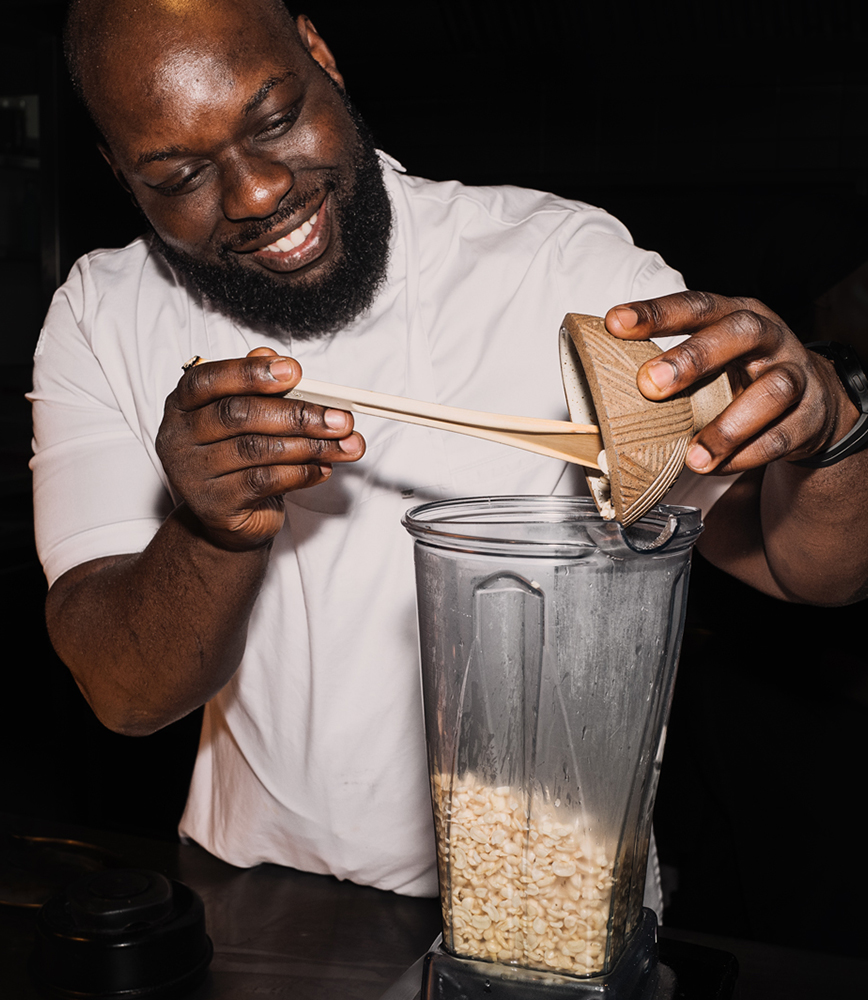 Authenticity is the core of my Nigerian cooking, even in a higher food setting. There seems to be a stereotype about West African and Nigerian cuisine that suggests it is basic, rustic and far too spicy. While it is true that Nigerian cuisine is kept simple, it is more than a few dishes of meat and veg. There are countless layers and depths of flavor in each dish that don’t rely on highly technical methods to achieve, making every dish delicious.
Authenticity is the core of my Nigerian cooking, even in a higher food setting. There seems to be a stereotype about West African and Nigerian cuisine that suggests it is basic, rustic and far too spicy. While it is true that Nigerian cuisine is kept simple, it is more than a few dishes of meat and veg. There are countless layers and depths of flavor in each dish that don’t rely on highly technical methods to achieve, making every dish delicious.
I grew up with simple and affordable Nigerian foods and still they remain some of the best things I have ever tasted. In my restaurant, we don’t use Nigerian cuisine as an afterthought. Instead, we place the core value and story as the star of the dish, pairing foods such as those listed above with high-quality fish or vegetables so diners can get to grips with the true taste of Nigerian food. It is the best method I have found for pulling the focus to overlooked Nigerian staples like black-eyed beans, giving the ingredients a chance to shine in a refined setting that they are not typically part of.
Traditional Processes In Modern Dishes
While my restaurant brings a touch of heritage to my black-eyed bean dishes, I can’t help but appreciate the creaminess of these beans. They’re a flavor carrier, helping to highlight the taste of other ingredients while bringing their own fun and allowing for endless experiments. Use this well-kept secret ingredient from West African cuisine to add a unique touch to your culinary creations.
The best way to include black-eyed beans in your dish is to follow traditional processes in preparing the beans; washing them, soaking them and skinning them for the smoothest results. But from that point on, they are yours to play with as you wish. You could even incorporate black-eyed beans as an alternative ingredient in gluten-free or vegan dishes when you are looking for a protein substitute without turning to the more processed options. Black-eyed beans are one of the easiest traditional ingredients to modernize and experiment with when you come to understand the loving act of their preparation.




